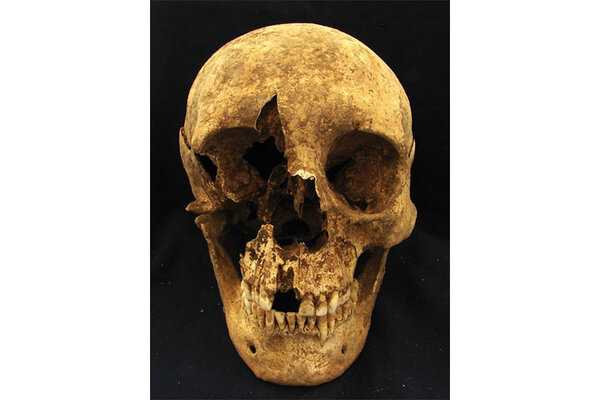Archaeologists analyzed isotopes in molars to begin personalizing the story of Rome’s hundreds of thousands of immigrants. Some came willingly, others did not.
By Molly Jackson February 11, 2016
-
 Courtesy of Kristina Killgrove
Courtesy of Kristina Killgrove
Who really lived in ancient Rome?
During the first few centuries AD, the city may have had 1 million residents: a huge size for an ancient city, but only a sliver of the empire’s almost 60 million residents, connected across diverse cultures and languages.
But as archaeologists Kristina Killgrove and Janet Montgomery indicate in the title of their newest study, “All Roads Lead to Rome,” migrants from all corners of the Empire made their way to the capital – some willingly, others as slaves.
To learn more about these Roman residents, the two archaeologists studied the isotopes in the tooth enamel of dozens of skeletons buried just outside the city, at the Casal Bertone and Castellaccio Europarco necropolises, “cities of the dead.”
Both necropolises were used until the 2nd century AD, primarily by lower-class Romans. Most graves have no decoration, markers, or objects buried with the dead, making it difficult to assess whether the skeletons belonged to slaves or citizens. Most of the teeth the team analyzed came from men up to the age of 50, according to their study, which was published Feb. 10 in PLOS ONE.
To determine the men’s origins, the researchers analyzed strontium, oxygen, and carbon isotopes in their tooth enamel for clues into the food and water they consumed.
Oxygen isotopes, for instance, can indicate the source of water human beings drank from while their tissues formed.
This was the first time researchers have applied the method to Imperial Roman skeletons.
Four of the individuals were born outside Rome, concluded Dr. Killgrove and Dr. Montgomery: three male adults, including one over age 50, and a teen between 11 and 15. Another four showed signs of possible migration: two children under 12, a teen boy, and an older teenage girl. The young children likely came to Rome between age four, when molar crowns finish forming, and their deaths at around age 10.
Where did they come from?
Although the researchers aren’t certain, the likely answer is, “All over.”
Oxygen isotopes help the archaeologists pinpoint longitude, while strontium isotopes reveal altitude: old mountains, like the Alps, show higher levels of 87-neutron strontium (87Sr) than younger rock, like volcanic areas of Italy. The ratio of 87Sr to 86Sr gets lower and lower as you travel from Italy’s knee to its toe, in other words.
Two of the migrants came from old-mountain areas like the Alps or islands in the Tyrrhenian Sea, while a third apparently came from Italy’s Apennine mountains. The last immigrant may have been born in Northern Africa, or else he just ate a lot of grain imported from there, as was common in Rome.
No matter where they came from, though, once they got to the imperial city, these immigrants ate like other Romans, say the researchers, based on comparisons between the carbon isotopes in their teeth to those in their bones: a diet heavy in wheat and beans, meat and fish. The diet change underscores a critical point: when in Rome (or its empire), you really did do as the Romans did.
“Rome was the world’s most successful multiethnic state until our own – and history’s longest lasting one, bar none,” wrote Cullen Murphy for the Los Angeles Times in 2007, comparing ancient Rome’s attitudes about immigration with modern American ones. “You would see something remarkably uniform from the Atlantic to the Euphrates, from Britain to North Africa,” thanks to policies and public values “that rapidly turned outsiders into insiders” – sometimes brutally.
Rome was even founded by an “outsider,” according to one classic tale: defeated Trojan hero Aeneas finally found welcome in Rome after years of wandering.
The history of Rome’s “outsiders,” as defined by birthplace and social class, has been largely forgotten, Killgrove and Montgomery argue, but new research blending historical accounts, bioarchaeology, and anthropology can help uncover what their lives were like in one of the world’s most complex cities for specific groups and individuals. That approach, they argue, could help “reveal the role that migrants had in shaping the history, culture, and geography of the Roman Empire.”